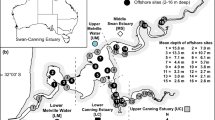Abstract
The inarticulated brachiopod, Lingula reevii Davidson (1880) is a filter-feeding invertebrate that burrows vertically in sandy or mixed sediments. Its only recorded occurrence is from Kaneohe Bay, Oahu, Hawaii, southern Japan, and Ambon, Indonesia. Past surveys of Kaneohe Bay populations suggested a distinct decrease in abundance following the diversion of sewage effluent from the bay in 1978/1979. In the summer of 2004 and 2007, visual surveys were conducted in areas of historical L. reevii abundance as well as in areas appearing to have suitable habitat. In 2004, approximately 2,950 m2 at 20 sites within the bay were surveyed using quantitative belt transecting methods. A maximum density of 4 Lingula/m2 was observed, a decrease from previous maximum estimates of 500 individuals/m2 (Worcester, Dissertation, Zoology Department, University of Hawai′i, pp 49, 1969) and 100 individuals/m2 (Emig, J Exp Mar Biol Ecol 52:47–61, 1981). When these 20 sites were revisited in 2007, many had fewer or no L. reevii; therefore, broader scale presence/absence surveys were conducted at 16 additional sites in the bay (also surveyed in 2004). The highest density of L. reevii found in 2007 was 0.94 individuals/m2. The continued decline in abundance of L. reevii in Kaneohe Bay may be due, in addition to decreased organic enrichment from diversion of sewage discharge almost 30 years ago, to the more recent reduction of suitable habitat by the invasion of mat-forming alien algae species.


Similar content being viewed by others
References
Cals P, Emig CC (1979) Lingules d’Amboine, Lingula reevii Davidson et Lingula rostrum Shaw, données écologiques et taxonomiques concernant les problèmes de spéciation et de répartition. Cah Indo-Pac 2:153–164
Chuang SH (1959) The breeding season of the brachiopod, Lingula unguis. Biol Bull 117:202–207
Emig CC (1978) A redescription of the inarticulated brachiopod Lingula reevii Davidson. Pac Sci 32:31–34
Emig CC (1981) Observations sur l’écologie de Lingula reevii Davidson Brachiopoda : inarticulata. J Exp Mar Biol Ecol 52:47–61
Emig CC (1984) Importance du sédiment dans la distribution des Lingules Brachiopodes, Inarticulés. Lethaia 17:115–123
Emig CC (1987) Phylum Brachiopoda. In: Devaney DM Eldredge LG (eds) Reef and shore fauna of Hawai′i, Sect. 2 & 3: Platyhelminthes through Phoronida, and Sipuncula through Annelida. Bishop Museum Press, Honolulu pp 167–170, Pl. 2
Emig CC (1997) Ecology of inarticulated brachiopods. In: Kaesler RL ed Treatise on Invertebrate Paleontology. Vol. 1, Part H. Brachiopoda. Geological Society of America and University of Kansas. Boulder, Colorado, and Lawrence, Kansas pp 473–495
Federal Register (2004) Endangered and threatened species: establishment of species of concern list, addition of species to species of concern list, description of factors for identifying species of concern, and revision of candidate species list under the Endangered Species Act. Vol. 69, No. 73. NOAA, US Department of Commerce. http://www.nmfs.noaa.gov/pr/pdfs/fr/fr64-19975.pdf
Hammond LS (1982) Breeding season, larval development and dispersal of Lingula anatina from Townsville, Australia. J Zool Lond 198:183–196
Hunter CL, Evans CW (1995) Coral reefs in Kaneohe Bay, Hawai′i: two centuries of western influence and two decades of data. Bull Mar Sci 57:501–515
Hyman LH (1959) The invertebrates: smaller coelomate groups, Vol. 5. McGraw-Hill, New York, pp 783
Kenchington RA, Hammond LS (1978) Population structure, growth and distribution of Lingula anatina (Brachiopoda) in Queensland, Australia. J Zool Lond 184:63–81
Paine RT (1963) Ecology of the brachiopod Glottidia pyramidata. Ecol Monogr 33:187–213
Park KY, Oh CW, Hong SY (2004) Population dynamics of an inarticulated brachiopod Lingula unguis on the intertidal flats of Kunsan, Korea. J Mar Biol Assoc UK 80:429–435
Raut D, Ganesh T, Murty NVSS, Raman AV (2005) Macrobenthos of Kakinada Bay in the Godavari delta, East coast of India: comparing decadal changes. Estuar Coast Shelf Sci 62:609–620
Rodgers SK, Cox EF (1999) Rate of spread of introduced Rhodophytes Kappaphycus alvarezii, Kappaphycus striatum, Gracilaria salicornia, and their current distributions in Kāne′ohe Bay, O′ahu, Hawai′i. Pac Sci 533:232–241
Roy KJ (1970) Change in the bathymetric configuration, Kāne′ohe Bay, O′ahu 1882–1969. University of Hawai′i, Hawai′i Inst Geophysics Tech Rept No. 70–15, 26 pp
Smith SV, Kimmerer WJ, Laws EA, Brock RE, Walsh TW (1981) Kāne′ohe Bay sewage diversion experiment: perspectives on ecosystems responses to nutritional perturbation. Pac Sci 35:279–402
Smith JE, Hunter CL, Smith CM (2002) Distribution and reproductive characteristics of non-indigenous and invasive marine algae in the Hawai′ian Islands. Pac Sci 563:299–315
Smith JE, Hunter CL, Conklin EJ, Most R, Sauvage T, Squair C, Smith CM (2004) Ecology of the invasive red alga Gracilaria salicornia (Rhodophyta) on Oahu, Hawaii. Pac Sci 58:325–343
Williams A, James MA, Emig CC, Mackay S, Rhodes MC 1997. Ecology of inarticulated brachiopods. In: Kaesler RL(eds) Treatise on invertebrate paleontology. Vol. 1, Part H. Brachiopoda. Geological Society of America and University of Kansas. Boulder, CO and Lawrence, KS, pp 7–188
Woo MML (2000) Ecological impacts of the introduced red alga, Kappaphycus striatum in Kāne′ohe Bay, O′ahu. Dissertation, Botany Dept, University of Hawai′i, pp 79
Worcester WS (1969) Some aspects of the ecology of Lingula Brachiopoda in Kāne′ohe Bay, Hawai′i. Dissertation, Zoology Dept, University of Hawai′i, pp 49
Acknowledgments
This research was conducted as part of the University of Hawaii’s Field Problems in Marine Biology course, Spring, 2004 and 2007. We thank D. Strang, S. Maynard, J. Ball, and the very helpful staff and students at Hawaii Institute of Marine Biology for their invaluable logistical and academic support and for use of the NSF Lab facilities. We also thank R. A. Kinzie III and J. H. Brock for constructive comments on the draft manuscript.
Author information
Authors and Affiliations
Corresponding author
Additional information
Communicated by P.W. Sammarco.
Rights and permissions
About this article
Cite this article
Hunter, C.L., Krause, E., Fitzpatrick, J. et al. Current and historic distribution and abundance of the inarticulated brachiopod, Lingula reevii Davidson (1880), in Kaneohe Bay, Oahu, Hawaii, USA. Mar Biol 155, 205–210 (2008). https://doi.org/10.1007/s00227-008-1018-8
Received:
Accepted:
Published:
Issue Date:
DOI: https://doi.org/10.1007/s00227-008-1018-8




